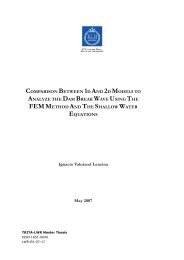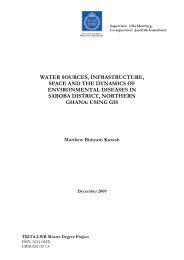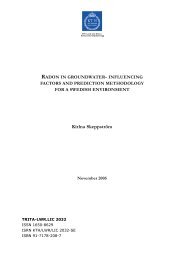POTENTIAL BIOGAS PRODUCTION FROM FISH WASTE AND ...
POTENTIAL BIOGAS PRODUCTION FROM FISH WASTE AND ...
POTENTIAL BIOGAS PRODUCTION FROM FISH WASTE AND ...
You also want an ePaper? Increase the reach of your titles
YUMPU automatically turns print PDFs into web optimized ePapers that Google loves.
Potential Biogas Production from Fish Waste and Sludge5.2. Biomethane PotentialIn this section, the analysis of results and the comparision to otherliteratures are presented in detail.5.2.1. Result analysis of this projectThe initial pH values ranged between 8.13 and 8.49 (Table 4) and afterdigestion the pH value was dropped till the range from 7.58 to 7.73(Table 6). It indicated that the quantity of acid produced from hydrolysisor acidogenesis did not inhibit the AD process. In the other words, thispH values were conducive for CH 4 production.As it was mentioned before (3.1.2 section), the fish intestine containedlots of enzymes promoting the hydrolysis of organics. Without it, theslow hydrolysis process could be one reason for less CH 4 production,such as the group A5 & B5 only containing fish meat mixed with sludge.In addition, the difference of MP between A1 and B1 after 13 days was0.131 Nm 3 CH 4/kg VS larger than it between A5 and B5. It could provethat the presence of cod intestine had a strong influence on thedigestibility of substrate. Therefore, cod intestine is the necessarysubstrate in the co-digestion of fish waste.The proportion of cod meat and cod intestine was determined by thequantity of additive sludge. For example, in Group B, the sludge wasmixed in the substrate occupied a half amount of total substrate, whichcontained abundant organics. Many enzymes were required fordegradation, which were produced from cod intestine. In the light of thecomparison of Group A and Group B, less sludge it was added, thehigher MP it could be obtained. The reason for that could becharacteristic of secondary sludge from Simrishamn which wasconstituted by microorganisms embedded in a matrix of extracellularpolymeric substances causing difficult degradation (Mcswain et al, 2005).From the observation of pH value in Group A, 33 % sludge mixed withcod meat and intestine did not bring the ammonia inhibition in thedigester. Therefore, in the further study, maybe 25 % sludge or muchless could be tried in order to discover the critical point of ammoniainhibition (Ward & Slater, 2002).The reason for two peaks in the digestion process could be the differentgrowth rates of different types of bacteria and their distinctive workingtimes. In addition, long retention time and the same incubationcondition as the AD situation created a stronger adaptability of bacteriato the current situation. It made methane flow rate reach to the firsthighest peak much earlier.5.2.2. Comparison analysis with other studiesThe optimal MP in this project is 0.533 Nm 3 CH 4/kg VS digested fromA4. To compare with Almkvist (2012) which had the highest MP0.503 Nm 3 CH 4/kg VS, it had improved the CH 4 yield by 6 %. But, itshould be noticed that the retention time in this project was less thanAlmkvist study, and the curve of MP from A4 still had the trend to goup later. In addition, the primary sludge was used in Almkvist study,which contained many easily degradable organic compounds than thesecondary sludge used in this project. As to compare with the best resultin Tomczak-Wandzel (personal communication, February 2012), the25.6 % was increased by this project. Adjusting the proportion ofsubstrate in this project indeed brought the improvement of biogasproduction from the co-digestion of fish waste and sludge.The digestion of fish waste could only produce scarce CH 4 due toexcessive nitrogen production. In the Mshandete et al (2004) study, the27
















